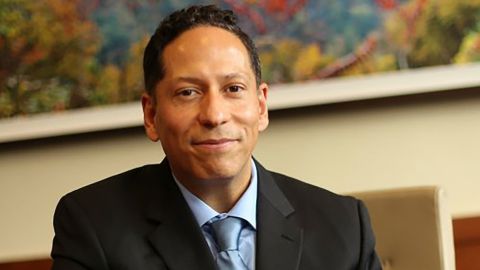[ad_1]
Editor’s Note: Vincent Guilamo-Ramos is the dean of the Duke University School of Nursing. A nurse practitioner, he specializes in the prevention of HIV/AIDS and sexually transmitted infections, and improving the lives of sexual minorities and other youth receiving HIV prevention and treatment. He serves as a member of the Department of Health and Human Services’ Presidential Advisory Council on HIV/AIDS. The views expressed in this commentary are his own. View more opinion on CNN.
CNN
—
The long fight to end HIV/AIDS has seen real progress spurred by innovative research, prevention, treatment and education. But our nation’s ambitious goal of ending the HIV epidemic by 2030 is nevertheless in peril.
This World AIDS Day, we must be honest with ourselves: We aren’t moving fast enough, and if we don’t make significant changes to how we fight the epidemic, we will fall short.

Our slow progress isn’t because we lack the tools. It’s because we haven’t used the tools to reach the people most in need.
Take, for instance, my 25-year-old patient Manny, who immigrated from the Dominican Republic and lives in a neighborhood where HIV rates are high and access to prevention and treatment is low. As a man who has sex with men (MSM), Manny should have been offered PrEP, a breakthrough medication that effectively prevents HIV infections and came to market in 2012. But he didn’t have a regular healthcare provider, spoke mostly Spanish, had no insurance and felt internalized shame about being gay. Manny only visited the health department when he developed a high fever and rash that covered most of his body. He tested positive for HIV.
Manny’s story isn’t unusual, and it highlights the healthcare access, policy and environmental challenges that threaten our ability to end HIV/AIDS and create a system that leaves many people behind.
Data from the US Centers for Disease Control and Prevention estimate that 34,800 Americans acquired HIV in 2019. That’s down just 12% cumulatively over the prior nine years. And it’s well off the pace required to reach the goal of ending the epidemic by 2030.
The same data reveals an opportunity for shifting our strategy to create more impact. Between 2010 and 2019 annual new HIV infections decreased among Black MSM by 1% and White MSM by 32%. But during the same period, new cases among Latino MSM increased by 16%. This reality reflects a glaring inequity: A lot of people still get HIV, and they don’t have to.
The tools and resources to address this inequity exist. We must use them differently. Here’s how:
In neighborhoods like Manny’s, the virus can spread at a rate much higher than in communities with sufficient access to prevention and treatment services. Currently, many states still have regulatory restrictions that prevent important members of the HIV care team (such as nurse practitioners, physician assistants and pharmacists) from independently providing the full range of prevention and treatment that would be consistent with their education and license. For example, nurse practitioners in Maryland can prescribe PrEP independently, while nurse practitioners just across the border in Pennsylvania need a collaborative practice agreement, which is designed to formalize oversight by a physician, to provide the same service.
This creates unnecessary barriers to optimally scaling up care for millions of Americans, including the 1.2 million living with HIV. But if, for example, nurse practitioners were permitted to practice at the highest level of their education and license independent of physicians in all states, including on HIV care teams, we could reduce the number of people living in counties with primary care shortages by 70%, according to a 2018 UnitedHealth report. We must encourage state legislatures to rescind such harmful state-level regulatory restrictions.
As Manny’s situation illustrates, access to PrEP isn’t universal. For many, PrEP may not be available in their community, healthcare providers experienced in managing PrEP may be too few and government-sponsored payment programs to cover PrEP costs may not exist.
For example, even though free PrEP coverage is mandated by the Affordable Care Act, a federal court in Texas ruled in favor of a business, Braidwood Management, that refused to offer PrEP coverage, leaving employees at-risk and underinsured.
HIV risk is influenced by the social context of where a person lives, has sex and forms relationships. To that end, here at the Duke University School of Nursing, we use a research-based tool to help providers, educators, researchers and policymakers refocus on the social determinants of health that impact HIV exposure and susceptibility.
Our framework allows them to consider unjust social processes and strength-based resilience factors that set people and communities up to thrive despite structural adversity. This makes it easier for practitioners to think about the dynamic, multi-level mechanisms involved, so they can design more effective programs that get results faster. We must use tools like this nationwide to tailor our interventions to tackle the root causes and make sense in people’s everyday lives.
Manny’s case illustrates how feelings about homosexuality and HIV are deep-seated and complex and keep many from seeking the help they need to stay HIV-negative or live healthy and safe lives with the disease. Our society continues to marginalize MSM and people who inject drugs, are at economic risk or who live with HIV.
Braidwood Management refused to offer PrEP coverage because it would “facilitate and encourage homosexual behavior, prostitution, sexual promiscuity, and intravenous drug use.” We must confront deeply ingrained beliefs like this that impact decision-making and care models.
The high and stagnant number of new infections should not be our reality decades into the HIV epidemic. And it doesn’t have to be. We can double down on more than 40 years in the fight against HIV and continue to take decisive and sustained action, informed by data and science, to expand the reach of HIV prevention, treatments and professionals. We have the knowledge. We have the tools. We have the resources. The question now is, do we have the will?
Source link



